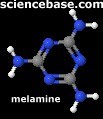 A brief summary and update to the Sciencebase original posts on Melamine in Milk and Melamine Scandal Widens.
A brief summary and update to the Sciencebase original posts on Melamine in Milk and Melamine Scandal Widens.
Dairy farmers have been feeling the squeeze for years, particularly in parts of the world where technological advancement has been slow in coming and so their profit margins on their milk output have not been lifted by improved efficiency. In order to boost profits milk has been diluted. However, this brings with it the problem of falling quality – dilute with water and measurable concentrations of milk proteins, fats, and sugars fall. Dilution by up to 30% has not been uncommon, which is where melamine (as I’ve mentioned) comes in. Melamine is a small organic molecule with a high nitrogen content that can easily fool the quality control equipment into thinking that nitrogen (from protein) is present at normal levels and so the milk is passed as good.
[Are_PayPal_LoginPlease]
Unfortunately, it is possible that melamine accumulates in the body and causes toxicity problems – basically damaging the kidneys and forming stones (solid deposits within the kidneys or bladder). Infants fed regularly with milk containing melamine will be particularly susceptible to these effects. As we have seen tens of thousands have been affected and several have died in China. Why this problem is not more widespread, given the rather large number of infants potentially having been drinking contaminated formula-milk for months is unclear.
Hsieh Teh-sheng, director of the Taiwan Urological Association and chief of Cathay General Hospital’s Department of Urology told the Taipei Times, that while there is no direct toxicity information on melamine’s health effects on people, the level of melamine found in the milk products is “not particularly high”. He says that kidney stones or other effects blamed on the melamine “could just as easily be caused by other harmful chemicals,” which is a point I discussed in the original post.
However, cyanuric acid is often present in melamine samples and the two can react together to form crystals, which can form stones. The current scandal could, whatever the final outcome, provide researchers with useful data on the effects of chronic exposure to melamine and its toxicity to the kidneys and bladder.
Sources in China have now said that Sanlu, which is at the heart of the controversy, was aware that its products were contaminated with melamine as long ago as December 2007. Fonterra, the New Zealand dairy company and 43% stakeholder in Sanlu claims to have approached the Chinese authorities as soon as it heard about the problem but was held back from going public because of the imminent Beijing Olympic Games. One can imagine there were additional pressures that prevented Fonterra from pushing for a solution. But, it cannot blame Chinese regulations for it failing to warn consumers as soon as it knew about the contamination.
Products across the globe containing milk imported from China seem to have been affected and authorities from Australasia and Asia to Europe and the US are withdrawing formula milk, coffee and tea drinks, candies, soup, cheese powder, biscuits, ready-made desserts, and chocolate. however, there are calls from some commentators that the US Food and Drug Administration (FDA) should be more forthright on its recommendations for consumers concerned with the melamine in milk scandal.
For those thinking of testing the products in their store cupboard, there’s a Craigslist item for sale here. It’s described as a “Rapid Melamine test kit—AgraQuant Melamine ELISA test kit”.
But, before you grab your credit card, think carefully whether you’d like to make ELISA (Enzyme-Linked ImmunoSorbent Assay) your friend. It’s a tricky test and probably not one you could rattle off in an afternoon with at least some biomedical background. Also, there’d be no point in testing your Ikea furniture for melamine, the “Melamine” they use is a polymer resin (a plastic, in other words) made from the small organic molecule melamine and formaldehyde, and no there’s no need to worry about using melamine cooking utensils or eating off a melamine-coated kitchen table.
[/Are_PayPal_LoginPlease]
 Four infants in China have died and at least 53,000 are reportedly ill, many seriously so, having been fed milk powder contaminated with the industrial chemical
Four infants in China have died and at least 53,000 are reportedly ill, many seriously so, having been fed milk powder contaminated with the industrial chemical  It is becoming apparent that contaminated baby formula is not the only problem. Milk, ice cream, yoghurt, confectionery such as chocolates, biscuits and sweets, as well as any foods containing milk from China have been banned from import into Singapore after the country’s agri-food and veterinary authority found melamine in imported samples. Similarly, Taiwanese authorities seized imported products after notification of contamination from Beijing earlier this month. Japan has recalled various products. Canada’s Food Inspection Agency has warned citizens not to eat a dessert – Nissin Cha Cha Dessert – imported from China that has been found to be contaminated with melamine. The authorities in the Philippines are currently testing.
It is becoming apparent that contaminated baby formula is not the only problem. Milk, ice cream, yoghurt, confectionery such as chocolates, biscuits and sweets, as well as any foods containing milk from China have been banned from import into Singapore after the country’s agri-food and veterinary authority found melamine in imported samples. Similarly, Taiwanese authorities seized imported products after notification of contamination from Beijing earlier this month. Japan has recalled various products. Canada’s Food Inspection Agency has warned citizens not to eat a dessert – Nissin Cha Cha Dessert – imported from China that has been found to be contaminated with melamine. The authorities in the Philippines are currently testing. Chernobyl. The very name strikes fear into the hearts of those who hate everything about the nuclear industry. It conjures up images of an archaic, burning industrial site spewing out lethal fumes, of farm animals dying of radiation poisoning in their thousands and contaminated meat, of ecosystems devastated, and of people with radiation sickness and for those spared the acutely fatal toxicity, the prospect of cancers to come and perhaps generations of mutations. But…
Chernobyl. The very name strikes fear into the hearts of those who hate everything about the nuclear industry. It conjures up images of an archaic, burning industrial site spewing out lethal fumes, of farm animals dying of radiation poisoning in their thousands and contaminated meat, of ecosystems devastated, and of people with radiation sickness and for those spared the acutely fatal toxicity, the prospect of cancers to come and perhaps generations of mutations. But… UPDATE:
UPDATE:  Melamine is an organic compound, a base with the formula C3H6N6. Officially it is 1,3,5-triazine-2,4,6-triamine in the IUPAC nomenclature system (CAS #108-78-1). It is has a molecular mass of just over 126, forms a white, crystalline powder, and is only slightly soluble in water. It is used in fire retardants in polymer resins because its high nitrogen content is released as flame-stifling nitrogen gas when the compound is burned or charred.
Melamine is an organic compound, a base with the formula C3H6N6. Officially it is 1,3,5-triazine-2,4,6-triamine in the IUPAC nomenclature system (CAS #108-78-1). It is has a molecular mass of just over 126, forms a white, crystalline powder, and is only slightly soluble in water. It is used in fire retardants in polymer resins because its high nitrogen content is released as flame-stifling nitrogen gas when the compound is burned or charred. Ultimately, the only truly safe sex is that practised alone or not practiced at all, oh, and perhaps cybersex. However, that said, even these have issues associated with eyesight compromise (allegedly), repetitive strain injury (RSI) and even electrocution in extreme cases of online interactions (you could spill your Mountain Dew on your laptop, after all). And, of course, there are popups, Trojans, packet sniffers and viruses and worms to consider…
Ultimately, the only truly safe sex is that practised alone or not practiced at all, oh, and perhaps cybersex. However, that said, even these have issues associated with eyesight compromise (allegedly), repetitive strain injury (RSI) and even electrocution in extreme cases of online interactions (you could spill your Mountain Dew on your laptop, after all). And, of course, there are popups, Trojans, packet sniffers and viruses and worms to consider… I’m not entirely convinced that bird flu (avian influenza) is going to be the next big emergent disease that will wipe out thousands, if not millions, of people across the globe. SARS, after all, had nothing to do with avians, nor does HIV, and certainly not malaria, tuberculosis, MRSA, Escherichia coli O157, or any of dozens of virulent strains of disease that have and are killing millions of people.
I’m not entirely convinced that bird flu (avian influenza) is going to be the next big emergent disease that will wipe out thousands, if not millions, of people across the globe. SARS, after all, had nothing to do with avians, nor does HIV, and certainly not malaria, tuberculosis, MRSA, Escherichia coli O157, or any of dozens of virulent strains of disease that have and are killing millions of people. I am once again drawn to research from a team at the University of Westminster, a renowned institution that doles out so-called science degrees in homeopathy. This time the paper in question, published in the inaugural issue of the International Journal of Food Safety, Nutrition and Public Health (2008, vol 1, issue 1, pp 16-32) is on that perennial favourite: what to do about the
I am once again drawn to research from a team at the University of Westminster, a renowned institution that doles out so-called science degrees in homeopathy. This time the paper in question, published in the inaugural issue of the International Journal of Food Safety, Nutrition and Public Health (2008, vol 1, issue 1, pp 16-32) is on that perennial favourite: what to do about the 
 rVita emailed me today to enthuse about a purportedly “wonderful resource”, which is apparently the web’s first integrative medicine community (funny they should claim that as I had someone else emailing to tell me yesterday about their first such site too).
rVita emailed me today to enthuse about a purportedly “wonderful resource”, which is apparently the web’s first integrative medicine community (funny they should claim that as I had someone else emailing to tell me yesterday about their first such site too).